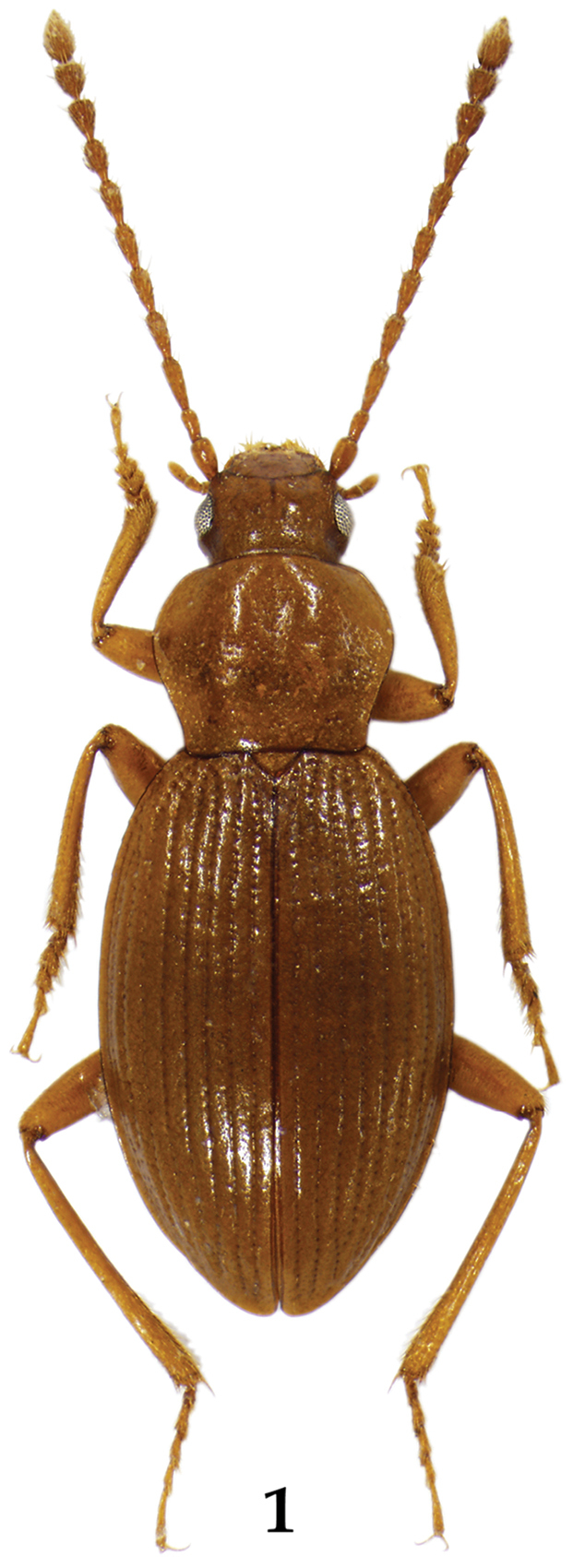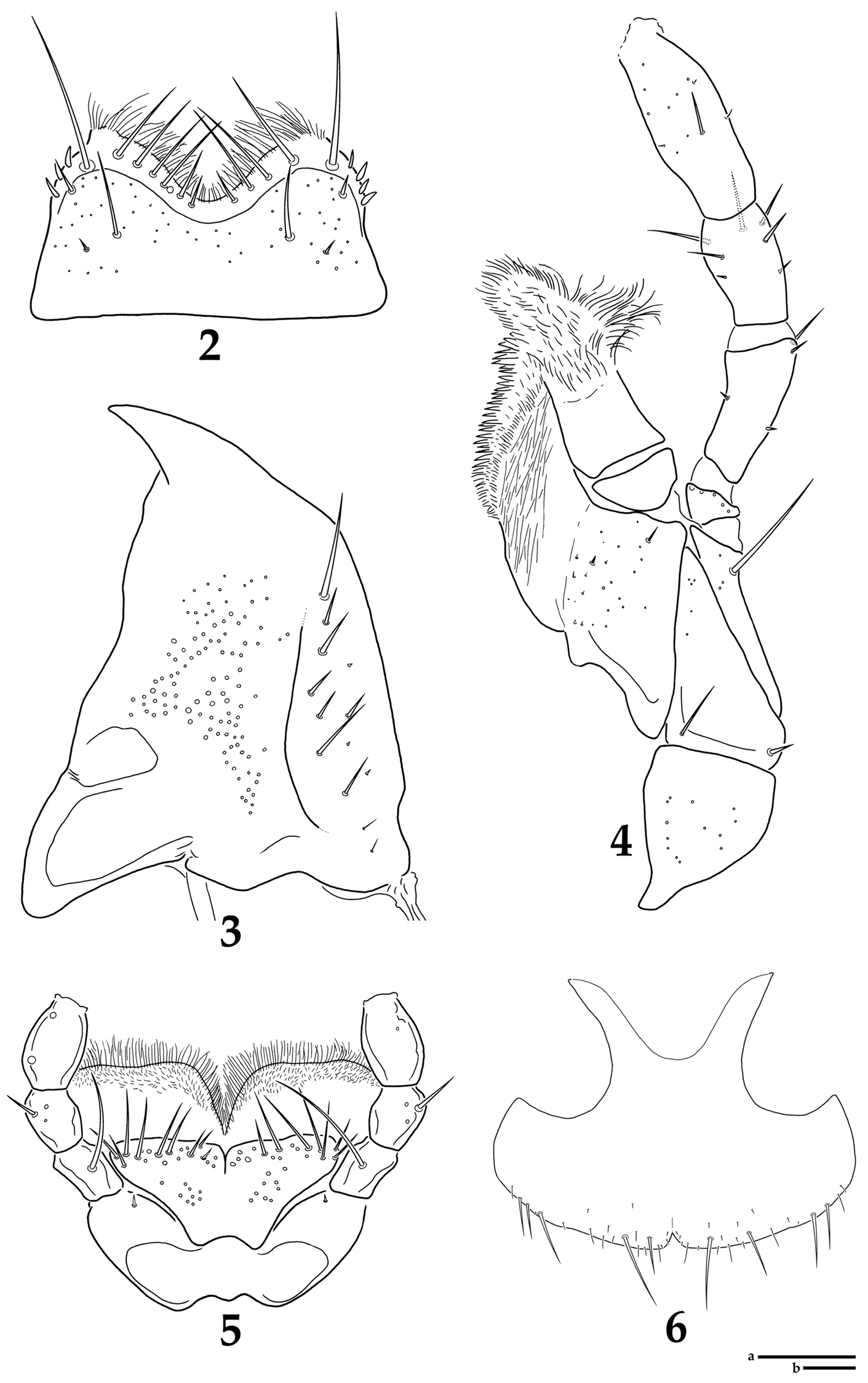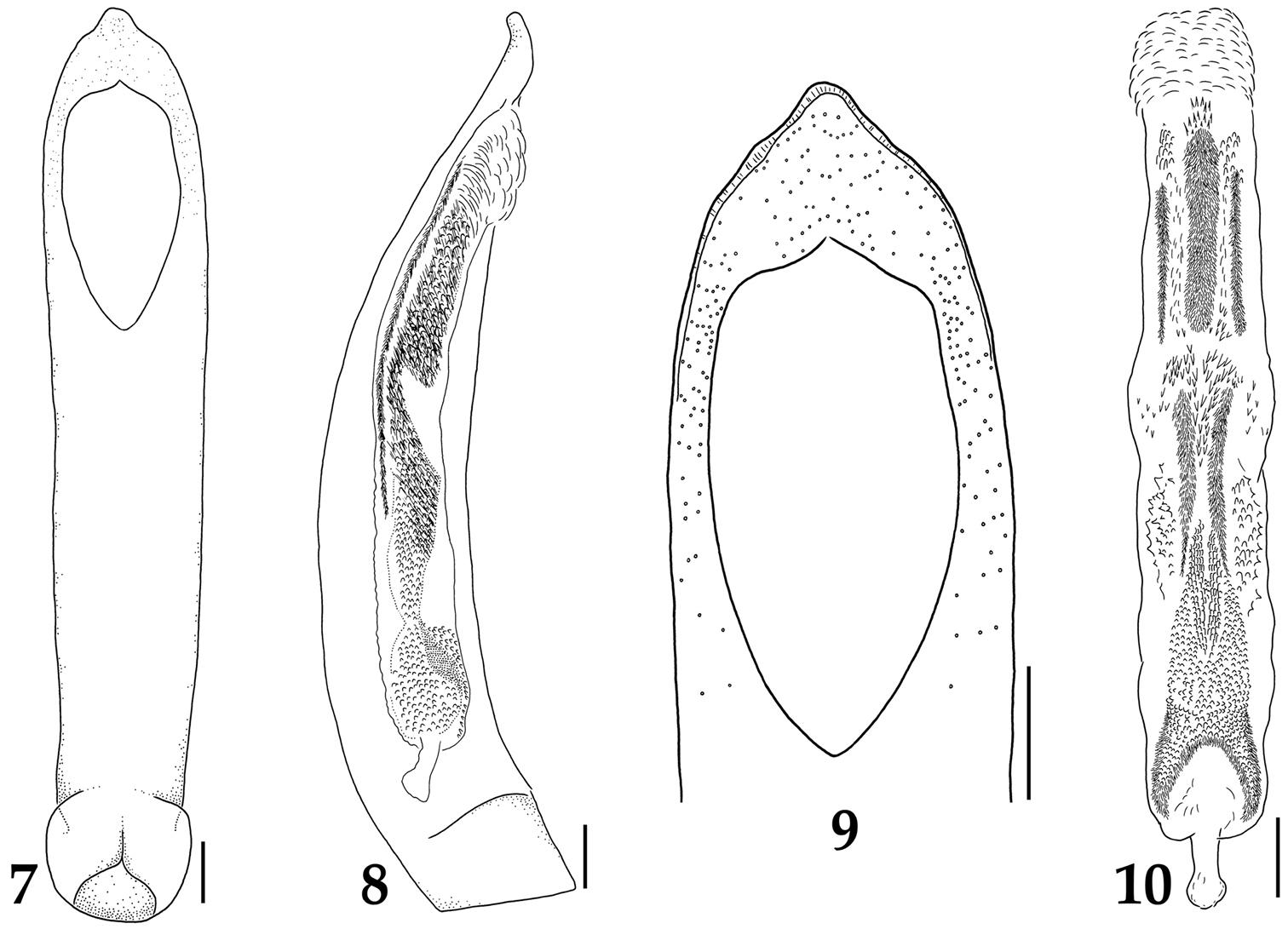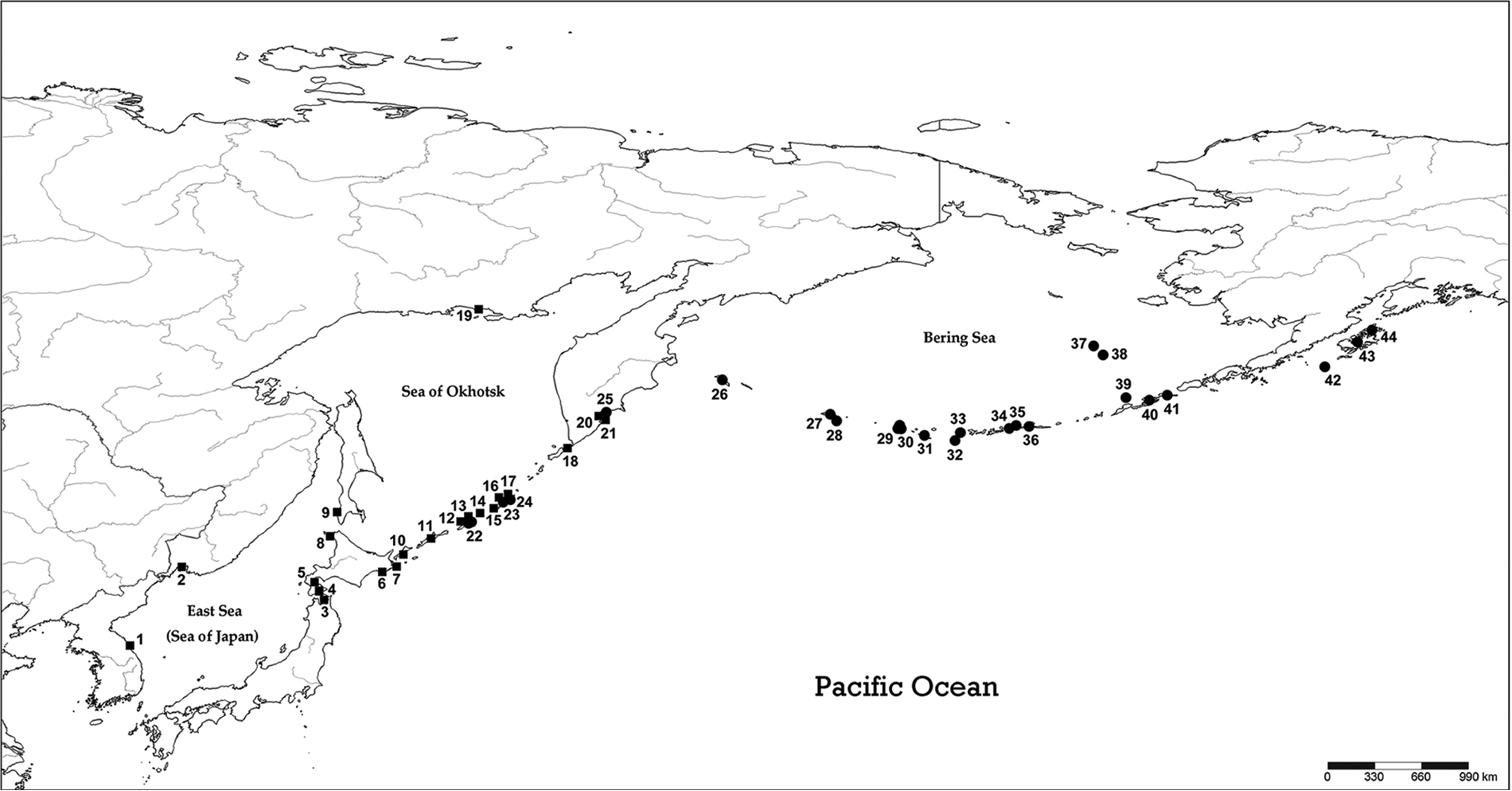






(C) 2013 In-Seong Yoo. This is an open access article distributed under the terms of the Creative Commons Attribution License 3.0 (CC-BY), which permits unrestricted use, distribution, and reproduction in any medium, provided the original author and source are credited.
For reference, use of the paginated PDF or printed version of this article is recommended.
Citation: Yoo I-S, Sikes D, Ahn K-J (2013) A redescripton of Lyrosoma pallidum (Eschscholtz) and distributional range extension of Lyrosoma Mannerheim (Coleoptera, Agyrtidae). ZooKeys 329: 23–32. doi: 10.3897/zookeys.329.4957
A redescription with illustrations of the species Lyrosoma pallidum and a key to the Korean species of the family Agyrtidae are provided. New distributional data, including a range extension, of the two Lyrosoma Mannerheim species are presented. Lyrosoma pallidum (Eschscholtz) is recorded for the first time in Korea.
Lyrosoma pallidum, L. opacum, distribution range, coastal, Agyrtidae
The genus Lyrosoma Mannerheim, containing two species worldwide, is confined to coastal habitats, such as under stones, seaweeds, and carcasses of various coastal animals along the seashore. They have also been reported in nests of maritime birds, but little is known regarding their immature stages and bionomics. They can be recognized by the combination of the following characters: mandibles without subapical teeth; antennomeres 9–10 each with apical grooves including compact distribution of sensilla; elytron with 9 striae; hind wings absent; pro- and mesotarsi dilated in males; aedeagus without parameres (
We collected a good series of Lyrosoma pallidum (Eschscholtz) along the seashores of Korea, Hokkaido (Japan), and Kamchatka (Russia). This species is a new addition to the Korean fauna.
All Lyrosoma pallidum specimens used in this study are deposited in the Chungnam National University Insect Collection (CNUIC), Daejeon, Korea. New data for Lyrosoma opacum are from specimens deposited in the University of Alaska Museum Insect Collection (UAM), Fairbanks, Alaska, USA. These data and all literature records reported here for Lyrosoma opacum are available online at http://arctos.database.museum/saved/Lyrosoma_opacum. Digital images of habitus were merged using image stacking software (Combine ZP). For measurement, we selected 10 males and 10 females (2♂1♀ from Korea; 5♂6♀ from Japan; 3♂3♀ from Russia) with maximum body size variation. The following abbreviations were used in the text: BL, body length (HL+PL+EL); HL, length of head from the anterior margin of the clypeus to the posterior margin of head; HW, width of head, including the eyes; PL, maximum length of pronotum; PW, maximum width of pronotum; EL, length of elytron from the base to the posterior margin of elytron; EW, width of elytra.
http://species-id.net/wiki/Lyrosoma_pallidum
Figs 1–10KOREA: Gangwon Prov.: 1♂1♀, Goseong-gun, Hyeonnae-myeon, Daejin-harbor, 38°29'59.1"N, 128°25'46.2"E 9 m, 29 V 2012, IS Yoo, JH Song, seaweeds on seawall; 1♂ (dissected), Sokcho-si, Daepo-dong, Oeongchi-beach, 38°11'01.3"N, 128°36'31.9"E 21 m, 28 V 2012, IS Yoo, JH Song, under seaweeds; RUSSIA: 15♂15♀ (1♂1♀ on slide, 8♂7♀ in 80% EtOH), Kamchatka, Petropavlovsk-kamchatsky, Avacha Bay, 53°01'26.4"N, 158°38'31.3"E, 25 VII 2011, KJ Ahn, IS Yoo, under debris on seashore; 2♂2♀ (7♀ in 80% EtOH), Kamchatka, Petropavlovsk-kamchatsky, Rescue Bay, 52°49'31.8"N, 158°35'51.1"E, 27 VII 2011, KJ Ahn, IS Yoo, seaweeds on rocky shore; 1♀ (in 80% EtOH), Kamchatka, Petropavlovsk-kamchatsky, Rescue Bay, 52°49'31.8"N, 158°35'51.1"E, 27 VII 2011, KJ Ahn, IS Yoo, seaweeds on sandy beach; JAPAN: 44♂54♀ (1♂1♀ on slide, 24♂30♀ in 80% EtOH), Hokkaido, Oshima, Minami-kayabe, Ôfuna, 42°00'01.9"N, 140°52'55.4"E, 7 VI 2012, KJ Ahn, IS Yoo, decaying seaweeds/starfish on seawall; 1♂, Hokkaido, Akkeshi, Tokotan, 15 VI 1994, K. J. Ahn, on rock crevice in high tide; 3♂18♀, Hokkaido Prov., Nemuro City, Hamamatsu, 26 IX 2000, H.-J. Kim, M.-J. Jeon, under stones.
Body (Fig. 1) general carabid-shape, yellowish brown to reddish brown, surface glossy with microsculpture. Male. BL: 4.3–5.1 mm. Head as long as wide or slightly wider than long (HL/HW: 0.94–1.00); eyes medium and prominent, separated by about 5 times of eye width; eye about 0.8 times as long as temple; short setae present between facets, shorter than facet diameter; vertex of head without pale mounds; epistomal suture indistinct; epicranial suture more or less Y-shaped; dorsal surface with rather dense isodiametric microsculpture, ventral surface with transverse microsculpture. Antenna filiform, about 3 times as long as HW, antennomere 2 shortest, 3 and 11 longest, 4–7 similar in shape and length, 9–10 with dense sensilla in apical grooves, 9–11 very weakly clubbed. Labrum (Fig. 2) transverse; anterior margin deeply and broadly emarginate; anterior and each anterolateral margin distinctly membranous and transparent; 4–6 long setae and single very long seta present on membranous part of each side of midline; 3–4 spinose setae present on each anterolateral region of membranous part; anterior margin of membranous part with dense micro setae; sclerotized part with two setae on each side of midline and one seta on each anterior corner; surface of sclerotized part with many pores scattered sparsely. Mandibles (Fig. 3) symmetrical, inner regions without tooth; broad at base and pointed at apex; dorsal and ventral surface with many pores on medial area. Maxilla (Fig. 4) with 4 palpomeres; palpomeres 2–4 with distinct setae. Labium (Fig. 5) with 3 palpomeres; palpomeres 1–2 with long setae, last palpomere asetose; ligula caudal fin-like shape and bilobed, each lobe with 7–10 long setae on subapical region; ligula with many pores on medial and subapical regions of each lobe; paraglossa broadly developed, anterior margin with many setae densely distributed. Mentum trapezoidal narrowing apically; anterior margin straight; single long seta present on each anterolateral region; many pores scattered sparsely and microsculpture transverse. Submentum with many pores, short setae present sparsely. Pronotum broad cordiform, wider than long (PL/PW: 0.81–0.84); pronotum widest near anterior third; anterior corners round, posterior corners angled; pronotum without mid-basal fovea; disc with shallow and broad medial-longitudinal depression. Elytra oval and convex, gradually increased to posteriorly in convexity; longer than wide (EL/EW: 1.41–1.59); each elytron with 9 striae; intervals as wide as width of first antennomere, weakly convex and impunctate, dense isodiametric microsculpture present; basal lateral margin weakly serrate; epipleura without distinct punctures. Hind wings absent. Mesoventrite glabrous and sculptured strongly; mesoventral process sharp, contiguous to metaventral process. Metaventrite covering many setae sparsely, metaventral process sharp. Pro- and mesotarsi dilated, tarsomere 1−4 with numerous setae ventrally. Metatarsi simple and long; last tarsomere about 1.8 times as long as tarsomere 4. Tarsal claws simple, basal part with very feeble tooth; two empodial setae present, as long as tarsal claws. Abdominal sternites covering many setae, surface with dense isodiametric microsculpture. Aedeagus (Figs 7–10) without paramere; median lobe long and slender, middle part of apex slightly protruded (Fig. 9); structure of internal sac as in Figs 8 and 10. Female. BL: 4.6–5.2 mm. Basically not differ to male. Pro- and mesotarsi not dilated. Sternite VIII (Fig. 6) with posterior margin emarginate narrowly, a few setae present on marginal region; spiculum ventrale broad, deeply emarginate anteriorly.
Lyrosoma pallidum (male from Goseong, Korea), body length 4.8 mm.
Lyrosoma pallidum. 2 labrum, dorsal aspect 3 right mandible, dorsal aspect 4 left maxilla, ventral aspect 5 labium, ventral aspect 6 female sternite VIII, ventral aspect. Scale bars, 0.1 mm (a: Figs 2–5; b: Fig. 6).
Aedeagus of Lyrosoma pallidum. 7 median lobe, ventral aspect 8 median lobe, lateral aspect 9 apex of median lobe, ventral aspect 10 internal sac, ventral aspect. Scale bars, 0.1 mm.
Korea (new record), Russia (Kamchatka, Kuriles, Magadan, Sakhalin) and Japan (Hokkaido, Honshu), Figure 11.
Distribution map of Lyrosoma pallidum (solid square, 1–21) and Lyrosoma opacum (solid circle, 22–44). 1 Korea: Gangwon Prov.: Goseong, Sokcho 2 Russia: Chasan: Barabasch 3 Japan: Honshu: Aomori 4 Japan: Hokkaido: Hakodate 5 Japan: Hokkaido: Oshima 6 Japan: Hokkaido: Akkeshi, Nemuro 7 Japan: Hokkaido: Cape Nosappu 8 Japan: Hokkaido: Rishiri-tô Island 9 Russia: Sakhalin: Pravda 10 Russia: Kurile Island Kunashir 11 Russia: Kurile Island Iturup 12 Russia: Kurile Island Urup 13 Russia: Kurile Island Cirpoi 14 Russia: Kurile Island Brouton 15 Russia: Kurile Island Simushir 16 Russia: Kurile Island Ketoi 17 Russia: Kurile Island Yanchika 18 Russia: Kurile Island Shumshu 19 Russia: Magadan 20 Russia: Kamchatka: Petropavlovsk 21 Russia: Petropavlovsk-Kamchatsky 22 Russia: Tairu nr Urup / Kurile Island Cirpoi 23 Russia: Kurile Island Ketoi 24 Russia: Kurile Island Yanchika 25 Russia: Kamchatka coast 26 Russia: Bering Island 27 United States: Attu Island 28 United States: Agattu Island 29 United States: Kiska Island 30 United States: Little Kiska 31 United States: Amchitka Island 32 United States: Amatignak Island 33 United States: Gareloi Island 34 United States: Ulak Island 35 United States: Kasatochi Island 36 United States: Atka Island 37 United States: St. Paul Island 38 United States: St. George Island 39 United States: Bogoslof Island 40 United States: Unalaska Island 41 United States: Rootok Island 42 United States: Chirikof Island 43 United States: Kodiak Island 44 United States: Afognak Island. Bold records: present study; others: previous distributional sites based on
http://species-id.net/wiki/Lyrosoma_opacum
See also http://arctos.database.museum/saved/Lyrosoma-opacum-new. USA: Alaska: 1 ex. Amatignak Isl., Ulva Cove, 3.9624m el. 51.26002°, -179.07718° ±5m ryegrass pebble beach, pitfall, 6JUN-31JUL 2009 D.S. Sikes; 16 ex. Bogoslof Isl., 1-44m el. 53.9308°, -168.03633° ±720m 16-17JUL 2008 D.M. Collet; 2 ex. Chirikof Isl, 55.82461°, -155.73598° ±3km back beach, hand, 30MAY-3JUN 2012 J.J. Withrow; 1 ex. Kasatochi E coast, upper shore, 52.17165°, -175.49229° ±2m under algae, 18JUN 2010 J. Slowik 1430-1515; 1 ex. Kasatochi, 1.524m el. 52.15905°, -175.4993° ±5m under kelp wrack, 13JUN 2009 J. Williams; 5 ex. Kasatochi, 12m el. 52.17177°, -175.52917° ±11m under rocks, scree, & grass, hand collected, 11JUN 2008 D.S. Sikes; 16 ex. Kasatochi, 3m el. 52.17912°, -175.49708° ±5m above beach, 12JUN 2009 J. Williams; 20 ex. Kasatochi, 3m el. 52.1796°, -175.49722° ±5m bird carcass, 12AUG 2009 D.S. Sikes; 8 ex. Kasatochi, 4.572m el. 52.17912°, -175.49708° ±5m above beach, under crested auklet carcass, 12JUN 2009 J. Williams; 2 ex. Kasatochi, E side, 18m el. 52.17416°, -175.49448° ±25m Peregrine falcon nest, carcasses of prey, 11AUG 2010 J. Williams; 2 ex. Kasatochi, E side, 4m el. 52.17371°, -175.49289° ±5m bird carcass, cliff base, 11AUG 2010 D.S. Sikes; 1 ex. Kasatochi, NE coast, 4m el. 52.18058°, -175.49878° ±8m fish carcass, back beach, 11AUG 2010 D.S. Sikes; 1 ex. Kiska Harbor, 3m el. 51.97823°, 177.53963° ±7m beach cave, 3m deep, 6AUG 2010 D.S. Sikes; 2 ex. Kiska Is., Sirius Pt., 15m el. 52.13293°, 177.59668° ±15m sand, Honkenya peploides, 5 pitfalls, 2-15JUL 2008 A. Bond; 5 ex. Rootok, 1m el. 54.05005°, -165.5112° ±5m in cracks back beach rocks, 12JUL 2009 D.S. Sikes; 1 ex. Ulak Isl., 1-160m el. 52.04187°, -175.90281° ±800m Elymus stand, 20JUL 2008 D.M. Collet.
Russia (Kurile Islands from Urup northwards, Kamchatka, Commander Islands), United States (Aleutian, Pribilofs, Kodiak, Afognak, and Chirikof islands), Figure 11.
The coastal genus Lyrosoma includes only two valid species. Lyrosoma pallidum can be distinguished from Lyrosoma opacum by its smaller body size, absence of epistomal suture and an elytral disc without distinct reticulation (
The key is modified from
| 1 | Antennomeres 2–5 each with apical grooves including compact distribution of sensilla (see |
Lyrosoma pallidum (Eschscholtz) |
| – | Antennomeres without apical grooves, sensilla sparsely present at the tip (see |
2 |
| 2 | Vertex of head without mounds analogous to ocelli; tibiae not carinate; aedeagus without parameres | Apteroloma kozlovi Semenov & Znojko |
| – | Vertex of head with one pair of mounds analogous to ocelli; tibiae carinate dorsally; aedeagus with parameres | 3 |
| 3 | Pronotum cordate, widest at anterior third, dense punctures present mostly along marginal region; aedeagus as in fig. 2F ( |
Pteroloma forsstromii (Gyllenhal) |
| – | Pronotum transverse, widest at the middle, dense punctures present excluding small part of central region; aedeagus as in figs 2A–B ( |
Pteroloma koebelei Van Dyke |
We thank Nina G. Klochkoba (Kamchatka State Technical University, Petropavlovsk-Kamchatsky), Masahiro Ohara (Hokkaido University Museum, Sapporo), and the United States Fish and Wildlife Service for arranging collecting trips. We thank Jeff Williams, Dominique Collet, and Jack Withrow who collected specimens representing new records. We also thank the following lab technicians at the University of Alaska Museum: Sayde Ridling, Megan McHugh, Ian MacDougall, and Mary Wyatt. This study was partially supported by Basic Science Research Program through the National Research Foundation of Korea (NRF) funded by the Ministry of Education, Science and Technology (2012-031412) and by “The Survey of Korean Indigenous Species” supported by National Institute of Biological Resources (NIBR) of Ministry of Environment of Korea.



